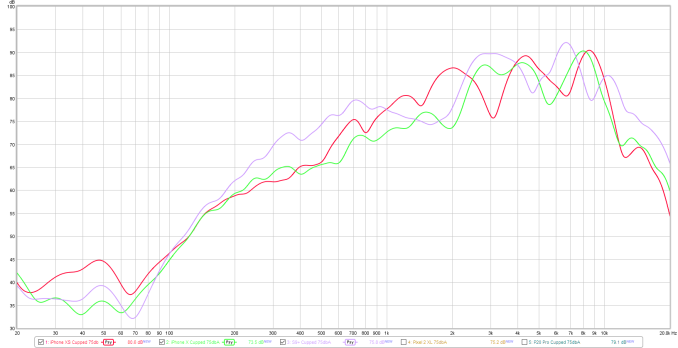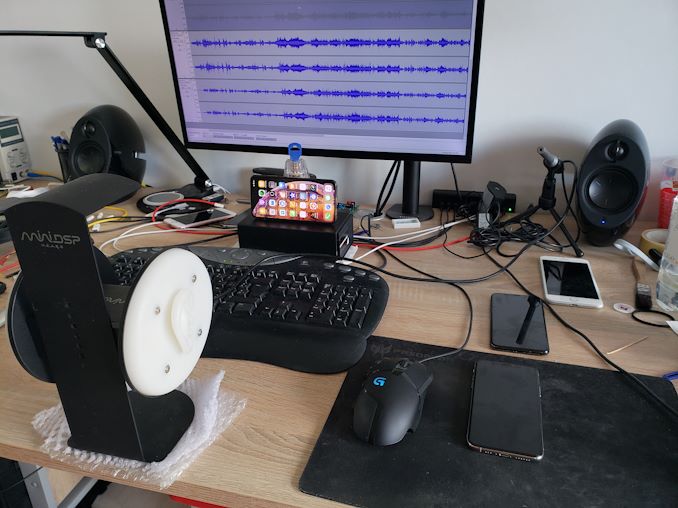The iPhone XS & XS Max Review: Unveiling the Silicon Secrets
by Andrei Frumusanu on October 5, 2018 8:00 AM EST- Posted in
- Mobile
- Apple
- Smartphones
- iPhone XS
- iPhone XS Max
Camera Video Recording
In terms of video recording, the iPhone XS promises an improved dynamic range in modes up to 30fps. What this likely means is that the phone’s able to capture in HDR mode in the 30fps modes, doing the same kind of processing we also see in SmartHDR still pictures.
Also something I’ve dreaded on iPhones for years; the new iPhone XS finally introduces stereo audio recording. Why it took Apple such a long time to finally introduce stereo recording is something that boggles the mind, but, let’s not complain, as we now finally have it on the new generation.
iPhone XS: iPhone X:
Comparing the iPhone XS video to the iPhone X, there’s one thing that is immediately very evident: the new XS is able to produce much better image stabilisation than last year’s flagship. Indeed, it looks like Apple vastly improved the OIS/EIS on the new phones, as the wobble that happens when walking is gone on the XS.
Audio recording finally is up to par, and we can hear the wind and rustling leaves of the trees around us. I think Apple might still have to work a bit on the wind noise cancellation, as in some parts the audio sounded as if it was inside a tube.
In terms of image quality, Apple’s claims of the improved dynamic range are very much verified. The phone showcases a lot more brought down highlights in the scene, and in darker areas, show better shadows. It’s unfortunate that this is limited only to the 30fps modes, but it’s understandable.
Switching over from the main lens to the telephoto lens happens relatively fast, although with a short exposure flash and a slight delay on the first zoom. 4K60 recording doesn’t allow for the use of the telephoto lens.
All in all, the video recording quality of the new iPhone XS is massively improved in all areas of stabilisation, picture quality, and audio. 4K30 recording on the XS is probably the best I’ve seen on any smartphone – a definitive applause to Apple for the improvements here.
Speaker Evaluation
Apple claimed to have improved the speaker audio quality on the new iPhone XS, allowing for more stereo separation and filling sound. I had introduced a new speaker evaluation method a few months ago because this year’s efforts by smartphone vendors to improve speaker quality has been very pronounced, and I wanted to have a way to objectively convey these improvements.
Starting off with speaker loudness, we’re measuring the phones at maximum volume, both in one-hand portrait mode, as well as two-handed mode where the palms are cupped towards the user. These two use-cases are what I find myself most often using the phone’s speakers in, so hopefully that also represents how most users use it as well, please let me know otherwise!

Using a pink noise signal, the iPhone XS pretty much falls into line with the results of the iPhone X, coming in at a very loud 82.8dBA in portrait mode and 87.6dbA in two-handed mode. Apple’s sound directionality on the iPhone X and XS is among the best, most likely due to the fact that the stereo earpiece is among the loudest of current generation smartphones.
Measuring the frequency response of the speakers, we see the iPhone XS closely following the measurement of the iPhone X, however there’s a major difference in the mid-range where the XS is around 5dB louder, raising instrumental frequencies and voices. This difference is what I think Apple is referring to when talking about better “fullness”, as it is evident when playing back media.
To better demonstrate the difference between the phones, I’ve attempted to capture them with a binaural microphone setup. Now I know my environment isn’t perfect as I don’t have the necessary sound dampening equipment, but I hope it does serve as an overall adequate A/B comparison between the phones. I’ve tried to calibrate the sound as much as possible recorded by the setup to a flat frequency response, although I’m sure there are improvements to be made. As a comparison, I also included calibrated speakers as a baseline to get an idea of the microphone setup.
The audio is meant to be listened to with headphones, or even better with IEMs, as this will give the intended playback of the binaural recording.
The iPhone XS’ improvements in the mid-range are quite evident as voices sound deeper and more pronounced on the new phone. Stereo separation is also quite good – resulting in a filling audio experience.
I included the S9+ and G7 as comparison devices. Samsung still does a significantly better job at the low-mid ranges which gives the phone more overall presence than the iPhones, also has an advantage in the very high frequencies giving more clarity, however the new iPhone’s XS strength point in the mid-ranges is the S9’s weakness, and vocals sound a lot less present than on the XS.
As for the G7, I just wanted to showcase a mono speaker device, and just how huge the audio difference is. Unfortunately the G7, even though it promises to have a good speaker, fails in practice.












253 Comments
View All Comments
Ansamor - Friday, October 5, 2018 - link
Same app for Android https://play.google.com/store/apps/details?id=com....tim1724 - Friday, October 5, 2018 - link
My iPhone XS scored 2162. :)DERSS - Saturday, October 6, 2018 - link
Is it much versus Kirin and Qualcomm or not?shank2001 - Saturday, October 6, 2018 - link
2868 on my XS Maxname99 - Saturday, October 6, 2018 - link
But it is unclear that the benchmark is especially useful. In particular if it's just generic C code (as opposed to making special use of the Apple NN APIs) then it is just testing the CPU, not the NPU or even NN running on GPU.You scored 2162. iPhone 6S scores 642 (according to the picture). That sort of 3.5x difference to me looks like a lot less than the boost I'd expect from an NPU, and may just reflect basically 2x better CPU plus availability of the small cores (not present on iPhone 6S).
edwpang - Friday, October 5, 2018 - link
There are no storage, network, and phone tests. Hopefully, these tests will included in future update.name99 - Friday, October 5, 2018 - link
"Apple promised a significant performance improvement in iOS12, thanks to the way their new scheduler is accounting for the loads from individual tasks. The operating system’s kernel scheduler tracks execution time of threads, and aggregates this into an utilisation metric which is then used by for example the DVFS mechanism."This is not the only changes in the newest Darwin. There are also changes in GCD scheduling. There was a lot of cruft surrounding that in earlier Darwins (issues of lock implementations, how priority inversion was handled, the heuristics of when a task was so short it's cheaper to just complete it than give up the CPU "for fairness --- but everyone then pays the switching cost"). These are even more difficult to tease out (and certainly won't present in single-threaded benchmarking) but are considered to be significant. There's also been a lot of thinking inside Apple about best practices for GCD (and the generic problem of "how to use multiple cores") and this has likely been translated into new designs within at least some frameworks and Apple's tier1 apps.
You can see this discussed here:
https://gist.github.com/tclementdev/6af616354912b0...
sheltem - Friday, October 5, 2018 - link
Can we chalk up the improvements of the 2x lens to computational HDR or is there a hardware improvement as well?darkich - Friday, October 5, 2018 - link
I just can't wait for Apple to FINALLY flesh out their in-house Mac chips.Not because I love Apple, but simply because I think the end result will be spectacular and outright shocking for Intel..and I do hate Intel.
They are disgustingly overrated.
varase - Tuesday, October 23, 2018 - link
I hope it's a good while ... I *need* VMWare and the ability to run Windows in a VM (for work).Not to mention, I'd be really disappointed if I couldn't boot Windows for game play.